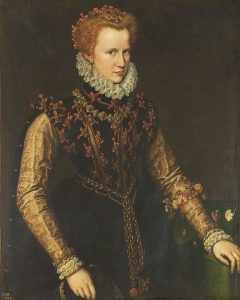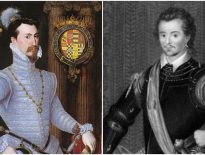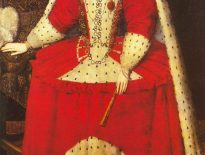 Jane Dormer became one of Queen Mary I’s foremost confidants during the 1550s. Born in 1538 at Eythrope, Buckinghamshire, she was the daughter of Sir William Dormer and Mary Sidney. Upon her mother’s death in 1542 she was brought up by her maternal grandparents. According to Jane’s biography, The Life of Jane Dormer, written by her secretary Henry Clifford) her upbringing shaped her academic career, as she ‘before seven years began to read the Primer or the office of our Blessed Lady, in Latin’. Evidently intelligent, the quote emphasises her traditional Catholic education with reference to the ‘blessed lady’. Her Catholicism, as shall be examined in this article, would later become symbolic of her identity. Similarly, her academic achievements in mastering languages were the result of her grandfather’s fluency, especially in Spanish; he served at the court of Charles V for a period.
Jane Dormer became one of Queen Mary I’s foremost confidants during the 1550s. Born in 1538 at Eythrope, Buckinghamshire, she was the daughter of Sir William Dormer and Mary Sidney. Upon her mother’s death in 1542 she was brought up by her maternal grandparents. According to Jane’s biography, The Life of Jane Dormer, written by her secretary Henry Clifford) her upbringing shaped her academic career, as she ‘before seven years began to read the Primer or the office of our Blessed Lady, in Latin’. Evidently intelligent, the quote emphasises her traditional Catholic education with reference to the ‘blessed lady’. Her Catholicism, as shall be examined in this article, would later become symbolic of her identity. Similarly, her academic achievements in mastering languages were the result of her grandfather’s fluency, especially in Spanish; he served at the court of Charles V for a period.
In 1547 at the age of nine Dormer began her service in Queen Mary’s household. She received the enviable opportunity of attending the queen at her coronation in September 1553, alongside eight other women. Throughout Mary’s short reign the women were inseparable, with the latter rarely permitting Jane’s absence from her presence. Similarly, Jane was provided with the opportunity of sleeping next to the queen in the royal bed, an honourable privilege that reveals a sense of devout companionship between the women. Although from a moderately wealthy family, Jane’s father held the post of the Knight of the Shire (Buckinghamshire), the Dormer family flourished financially under Mary’s reign as the result of Jane’s influence with the queen.
There is little evidence recording Dormer’s physical appearance, but a poem by Richard Edwards held in the British Library alludes to it. Stating that ‘she is of suche licely hewe that who so fedes his eyes on her sone her bewtevul’. Evidently, contemporaries found her strikingly beautiful. To support this, a portrait held at the Museo del Prado in Madrid, believed to be Lady Dormer, depicts a fresh-faced woman dressed in a flattering gown decorated with intricate, delicate ribbons.
In a period where a woman’s inner virtue was representative of her physical appearance, Dormer made a successful marriage with Gomez Suarez de Figueroa, the count of Feria (dukedom given in 1567). He was first introduced to Jane in 1554 upon his arrival in England as a member of Philip II’s encourage; the Spanish king who would soon become Mary’s controversial husband. Feria found her desirable, and in 1558 the two were to be wed, with the queen’s unwavering support. The ceremony took place in secret on the 29th December 1558, as a result of Queen Mary’s death and the potential animosity it might cause in Elizabeth I’s reign.
After Mary’s death, Dormer moved to Spain with her husband, likely the result of the new queen’s re-introduction of Protestantism. It was reported that her husband, Feria, had absented himself from the new queen’s coronation; a gesture that infuriated the queen. Similarly, Dormer may have realised that she would unlikely fashion a similar relationship with Elizabeth as she did with her predecessor, likely the result of their differing views on scripture. Upon leaving England, Dormer brought several women from the previous queen’s household to join her in Spain, including Susan Clarenius and her cousin Margaret Harrington; women of the Catholic faith, with the former dying there in 1564. Dormer enjoyed a reputable reputation on the continent and while on her journey to Spain her entourage visited the French court of Mary Stuart, Queen of France and Scotland. Upon Dormer’s arrival, Mary presented Jane with the utmost courtesy and lavished sumptuous gifts on her and ‘entreated the duchess that she also would be apparelled after the French manner’. This sense of courtesy reveals both Mary’s desirable hospitality and her respect for Dormer; likely the result of their shared, steadfast support of the Roman faith. The women would remain friends until Queen Mary’s execution in 1587.
Dormer had a well-established reputation in Spain, building a household renowned as an institution of papal authority. Due to Dormer’s relationship with England’s former queen, she became a reliable and knowledgeable source of information that benefited the Spanish court in terms of Anglo-Spanish relations. Additionally, her household retained links to England, as she received English merchants at her house who in turn sent her gifts of English produce. While she never formed a more than amicable relationship with Queen Elizabeth they remained civil, and Thomas Chaloner once reported that upon hearing of the queen’s recovery from smallpox in 1563 Dormer was ‘most joyful’.
Upon her husband’s death in 1571 Dormer was entitled to exert her influence further, both domestically and within the contemporary political world. She became a source of female independence, managing her substantial household and her son’s education. Alongside this, relations between her and England became stronger. This is evident in 1571 when she was sought to advise on the potential marriage between Elizabeth I and the Duke of Anjou. Jane’s correspondence with members of the English court and her hospitality to Englishmen in Spain solidified her importance as a potential mediator between the two countries. Similarly, she became known as ‘protectoress’ of English Catholics, due to her household’s reputation as an internationally renowned institution for educating the daughters of English Catholics. It provided a safe environment in comparison to the anti-Catholic sentiment felt in England.
During her later life, Dormer attempted to wield political influence with the Spanish king. As a result of her wealth, she reportedly sold two statues of the Virgin to purchase arms and munitions for a purported Spanish attack against England. While amicable with Elizabeth, Jane’s unwavering support of the Catholic faith was of more importance than maintaining good relations with the English queen who was ultimately viewed by Spaniards as a heretic usurper. While historians argue that Dormer never altered nor influenced King Philip’s policy directly, there were instances of her political endeavours. In 1596, she presented the king with a document that her supporters had also signed. It requested that Philip should make a public declaration to the effect that his daughter, Isabel, was the rightful claimant to the throne of England; Philip ultimately rejected the proposal. This was likely the result of Spain’s failed attempt to claim authority over England during the Spanish Armada campaign in 1588. Similarly, animosity between the two countries was more than apparent in the 1590s, due to several failed Spanish attempts to invade England. Acknowledging Isabel as the rightful claimant to the English throne would only further fuel antagonism between the two countries. One of Dormer’s final political acts was a letter she reportedly sent to James VI of Scotland upon his accession to the English throne as James I, stressing that he should embrace the Catholic faith. This was a vain attempt by Dormer; likely the result of her fondness for his mother, Mary, who was immortalised as an upholder of the true religion by many continental Catholics.
Any desire of Dormer to involve herself in politics was brought to an abrupt end with the Treaty of London in 1604 that concluded the nineteen-year Anglo-Spanish war. James I, in contrast to Elizabeth, desired friendly relations between the two countries. He was an idealistic practitioner of Christian peace and unity, realising the benefits of peace; less of a drain on English recourses.
During her life, Dormer was an intelligent and forthright woman. Through her independence as a wealthy widow, she utilised her household to establish an institution dedicated to upholding Catholicism, while maintaining its status as a secondary royal court, receiving a variety of English and Spanish guests. Dormer outlived her only son, Lorenzo, and died at the age of seventy-four on 13th January 1612. She was buried on 26th January at the monastery of Santa Clara at Zafra.
Written by Alexander Taylor.
Notes and Sources
Picture: Portrait of a woman thought to be Jane Dormer, Duchess of Feria, by Antonis Mor, Museo del Prado, Madrid.
- Crummé, Hannah L, "Jane Dormer's Recipe for Politics", in ed. Akkerman, Nadine and Houben Birgit (2013) The Politics of Female Households: Ladies-in-waiting across Early Modern Europe, BRILL.
- Rodriguez-Salgado, M. (2004-09-23). Suárez de Figueroa [née Dormer], Jane, duchess of Feria in the Spanish nobility (1538–1612), noblewoman and courtier. Oxford Dictionary of National Biography.



I once stayed at the Parador in Zafra for a few days, never realizing that it was the home of the Dukes of Feria and hence of Jane Dormer. So easy to miss in pre-internet times! Lovely castle, lovely town. I wish I had known the history of it at the time!
Paradors are lovely hotels, aren’t they? Always historic settings.
Yes, always used to love staying at them.